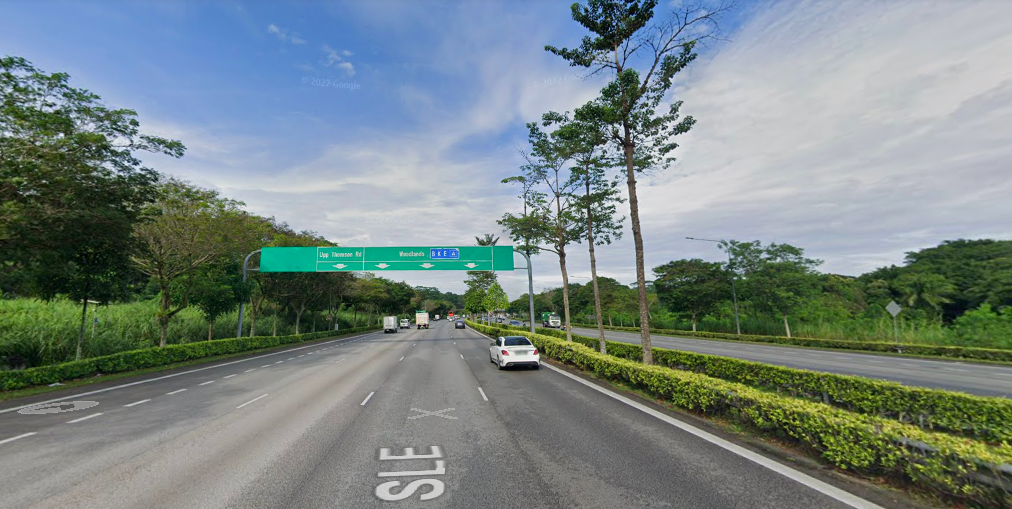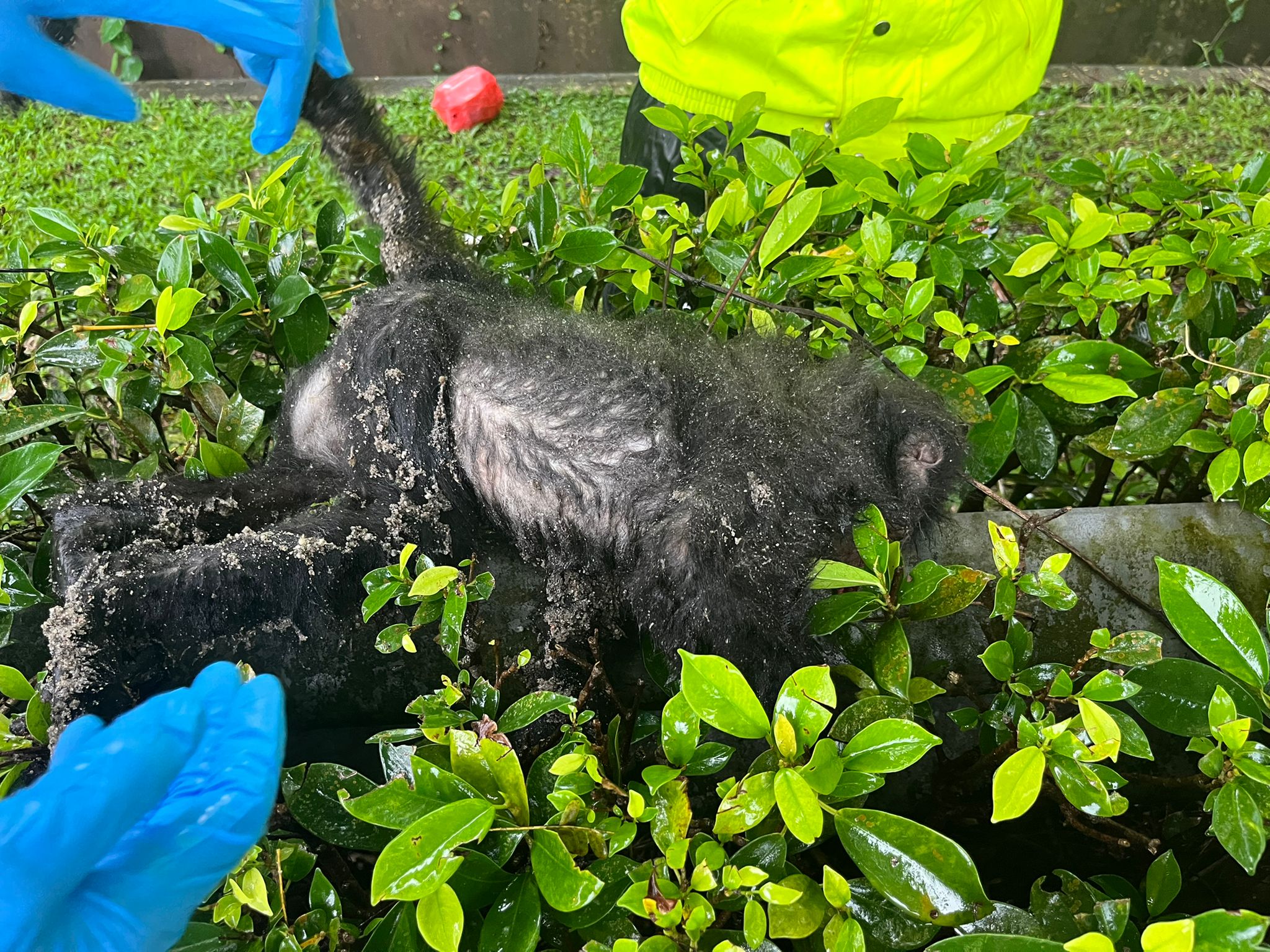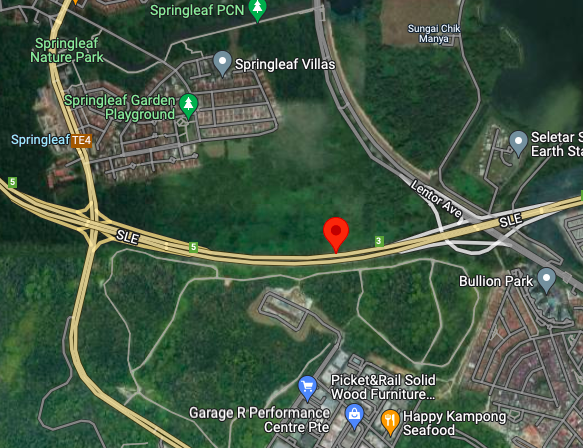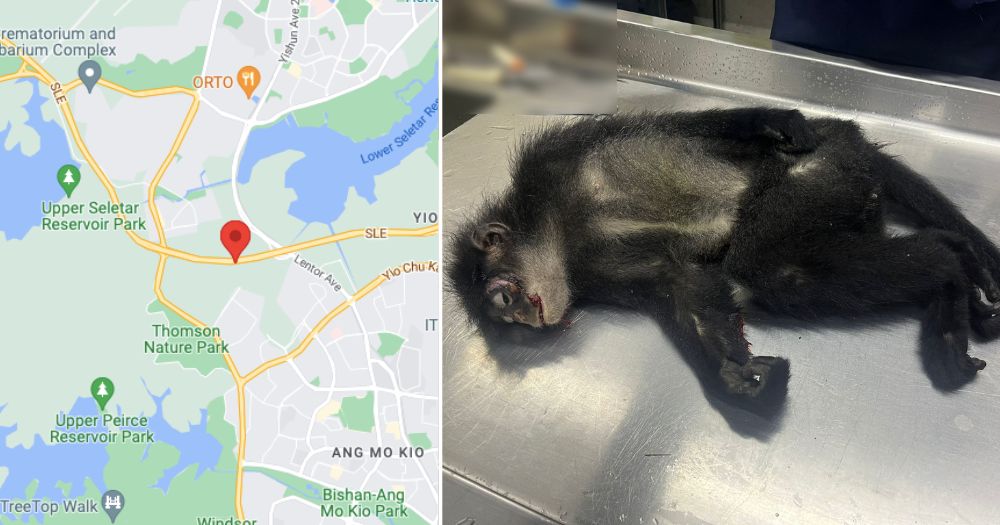Follow us on Telegram for the latest updates: https://t.me/mothershipsg
Two Raffles' banded langurs were found dead within 24 hours of each other along the Seletar Expressway (SLE) on Dec. 5 and 6.
These deaths are concerning for the future of the species, and a third individual, a group mate, is likely to attempt crossing the SLE as well.
Why they crossed the SLE
Based on the post-mortem results, the two male langurs died while crossing the expressway from the forested areas in Lentor to Springleaf.
These primates are arboreal and they would only descend to the ground if they had to cross between forest fragments without sufficient canopy connectivity.
Here, the langurs likely crossed the road to look for females to mate with or due to disturbances in their habitat, primatologist Andie Ang told Mothership.

The death of the first male juvenile primate was brought to her attention just before 12pm on Monday after it was spotted by a member of the public.
It was picked up with the help of Land Transport Authority (LTA) staff and traffic police.
 First individual. Photo by Andie Ang.
First individual. Photo by Andie Ang.
The next day, a second male subadult was collected by the Animal Concerns Research and Education Society (Acres).
 Second individual. Photo by Andie Ang.
Second individual. Photo by Andie Ang.
The carcasses were taken to Mandai Wildlife Group’s Wildlife Healthcare and Research Centre for a post-mortem examination.
Five langurs have been killed on the roads since 2011. Last year, a male juvenile ended up as roadkill along Upper Thomson Road.
Remaining langur in the group may cross the road
Ang, who also chairs the Raffles’ Banded Langur Working Group, told Mothership that based on the age, sex, and the time and location of the deaths, the two monkeys were part of a known group of at least three male bachelors.
Since 2017, the group has been documented crossing Upper Thomson Road through the canopy and visiting the Singapore Ministry of Defence's (MINDEF) state land, a forest patch that flanks SLE.
Based on her observations, the juvenile langur that was found dead on Monday is likely the same individual that was rescued by Acres when it was stranded in a concrete drain in Yio Chu Kang in July this year.
In search of a mate, groups of male bachelors tend to move around more and have a larger home range than family units.
Ang recommends members of the public to keep an eye out for the remaining primate when they are driving in the area, which is likely to cross the road as well.
If you see a stranded animal, do alert the LTA or the National Parks Board's (NParks) 24-hour Animal Response Centre at 1800-476-1600.
The stretch along SLE to take note of is after the Lentor entrance and before the Upper Thomson exit.

Deterring animals from accessing the road
In the meantime, Ang shared that the Raffles’ Banded Langur Working Group is working closely with NParks and relevant authorities to look at how to deter animals from accessing the road.
This short-term measure could look like pruning trees near the expressway to remove the animal's access to the roadside trees from the forest.
Solutions like building another Eco-Link or implementing rope bridges are not exactly feasible for SLE, said Ang.
"In terms of long term and across Singapore, the priority is to preserve whatever habitats we have. By shrinking the habitats for other purposes, you are reducing the size of the home range of various animals, then they would definitely have to move out of their home range."
Additionally, such incidents can be further prevented by identifying hotspots of animal movements through tracking roadkill or via observation, and strengthening the connectivity between habitats in such areas to make it safer for wildlife to cross.
Smaller population can lead to inbreeding
These two deaths mean the number of Raffles' banded langurs in Singapore have fallen to just 73.
Ang said that this is "concerning" as it means a smaller and less diverse gene pool for the species, which could lead to inbreeding.
Inbreeding is an issue that has already been recorded in the local population, added Ang.
This could lead to reduced fertility, greater vulnerability to diseases, genetic disorders and higher infant mortality.
The critically endangered species is endemic to Singapore and Malaysia, meaning it is not found anywhere else in the world except in this region.
NParks will monitor situation
In response to Mothership's queries, NParks said that it is in discussions with the Raffles' Banded Langur Working Group and Roadkill Monitoring Group to "monitor the situation and identify mitigating measures to prevent similar incidents".
"With the recent incidents involving the Raffles’ Banded Langurs along the SLE and its proximity to forested areas, we would like to call on motorists driving in the area to drive with caution and be alert to any potential animal crossings.
Members of the public are reminded not to handle injured wild animals on their own. For urgent reports of wildlife requiring rescue, they may contact NParks’ 24-hour Animal Response Centre at 1800-476-1600 or contact us at www.avs.gov.sg/feedback."
NParks said that it has been improving the langurs' habitat through reforestation and enrichment plantings to boost their population.
For example, Thomson Nature Park was sensitively enhanced with the planting of food plant species for the langurs such as the Radermachera pinnata and Nothaphoebe umbelliflora.
Rope bridges have been installed long Old Upper Thomson Road where the langurs have been observed to habitually cross, and in the recent development of Rifle Range Nature Park to facilitate arboreal mammal crossings.
"NParks is also working with the Land Transport Authority on the feasibility of installing rope bridges across other roads in the vicinity of where the Raffles Banded Langur occurs, such as Upper Thomson Road," it added.
Top image by Andie Ang.
If you like what you read, follow us on Facebook, Instagram, Twitter and Telegram to get the latest updates.

